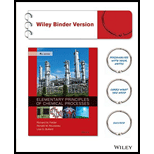
Concept explainers
(a)
Interpretation:
If the data support this prediction should be identified. The value of k should be determined.
Concept introduction:
A chemical reaction is carried out to convert the reactant A to the final product B. A set of data is taken by measuring the concentration of A with time (t). The author has predicted a reaction
The proposed reaction mechanism predicts that CA and t should be related by the expression,
The
(b)
Interpretation:
If the tank volume is 125 L and there is no B in the tank at t=0, the mass of the content in tank after two hours should be calculated.
Concept introduction:
A chemical reaction is carried out to convert the reactant A to the final product B. A set of data is taken by measuring the concentration of A with time (t). The author has predicted a reaction mechanism for this reaction.
A proposed reaction mechanism predicts that CA and t should be related by the expression,
(c)
Interpretation:
The time required for the final concentration of A to reach 1.1.1.05 and 1.01 times CAe , should be estimated and the mass of B produced at each of these conditions for the reactor described in Part (b) should be calculated.
Concept introduction:
A chemical reaction is carried out to convert the reactant A to the final product B. A set of data is taken by measuring the concentration of A with time (t). The author has predicted a reaction mechanism for this reaction.
A proposed reaction mechanism predicts that CA and t should be related by the expression,
Want to see the full answer?
Check out a sample textbook solution
Chapter 2 Solutions
Elementary Principles of Chemical Processes, Binder Ready Version
 Introduction to Chemical Engineering Thermodynami...Chemical EngineeringISBN:9781259696527Author:J.M. Smith Termodinamica en ingenieria quimica, Hendrick C Van Ness, Michael Abbott, Mark SwihartPublisher:McGraw-Hill Education
Introduction to Chemical Engineering Thermodynami...Chemical EngineeringISBN:9781259696527Author:J.M. Smith Termodinamica en ingenieria quimica, Hendrick C Van Ness, Michael Abbott, Mark SwihartPublisher:McGraw-Hill Education Elementary Principles of Chemical Processes, Bind...Chemical EngineeringISBN:9781118431221Author:Richard M. Felder, Ronald W. Rousseau, Lisa G. BullardPublisher:WILEY
Elementary Principles of Chemical Processes, Bind...Chemical EngineeringISBN:9781118431221Author:Richard M. Felder, Ronald W. Rousseau, Lisa G. BullardPublisher:WILEY Elements of Chemical Reaction Engineering (5th Ed...Chemical EngineeringISBN:9780133887518Author:H. Scott FoglerPublisher:Prentice Hall
Elements of Chemical Reaction Engineering (5th Ed...Chemical EngineeringISBN:9780133887518Author:H. Scott FoglerPublisher:Prentice Hall
 Industrial Plastics: Theory and ApplicationsChemical EngineeringISBN:9781285061238Author:Lokensgard, ErikPublisher:Delmar Cengage Learning
Industrial Plastics: Theory and ApplicationsChemical EngineeringISBN:9781285061238Author:Lokensgard, ErikPublisher:Delmar Cengage Learning Unit Operations of Chemical EngineeringChemical EngineeringISBN:9780072848236Author:Warren McCabe, Julian C. Smith, Peter HarriottPublisher:McGraw-Hill Companies, The
Unit Operations of Chemical EngineeringChemical EngineeringISBN:9780072848236Author:Warren McCabe, Julian C. Smith, Peter HarriottPublisher:McGraw-Hill Companies, The





